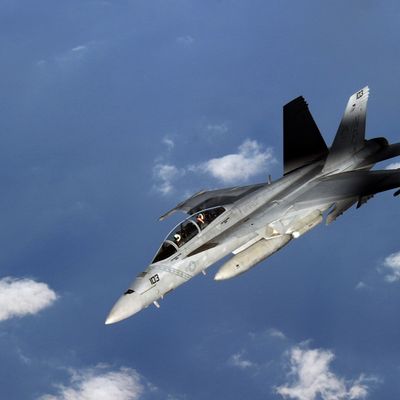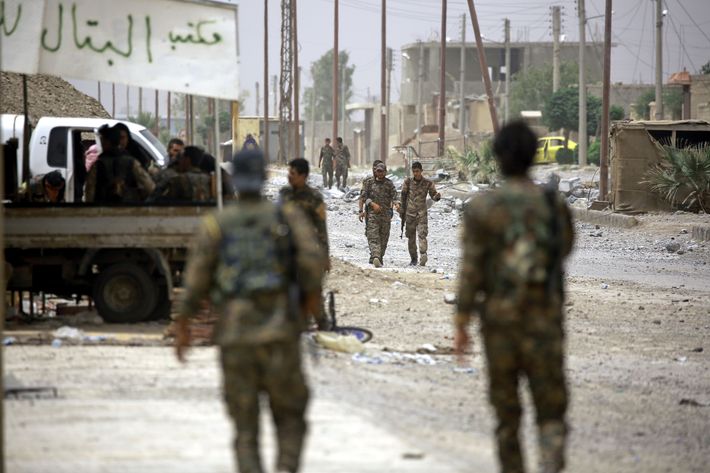
A U.S. fighter jet shot down a Syrian warplane on Sunday, marking an unprecedented new escalation in the conflict between the U.S. and its allies and the Assad regime in Syria. U.S. Central Command told Reuters that the plane was shot down in “collective self-defense of coalition partnered forces” after it had targeted U.S.-backed forces near the ISIS-held city of Raqqa. The Syrian army, meanwhile, claims the fighter jet was conducting a mission against ISIS militants. Either way, it’s the first time the U.S. has shot down a Syrian aircraft since the beginning of the country’s civil war in 2011, and the first time it has shot down a manned warplane anywhere in more than a decade.
The Pentagon says that the incident followed an earlier skirmish between U.S.-backed Syrian Democratic Forces (S.D.F.) and Syrian-government-backed forces near Raqqa in North Syria. The U.S. claims that the Syrian forces, including regime aircraft, attacked the S.D.F fighters and then did not respond to the U.S. military’s attempts to halt the attack through a de-confliction channel; the attack didn’t stop until U.S. warplanes buzzed the area in a show of force. A few hours later, a Syrian SU-22 fighter jet attacked the same S.D.F. fighters and was quickly shot down by an American F/A-18, reportedly killing the Syrian pilot. The U.S. claims the action was justified under the rules of engagement and because it was in self-defense of U.S.-backed forces, but it also made clear that the U.S. will now be willing to target any regime aircraft that threatens U.S. allies on the ground.
“The coalition does not seek to fight Syrian regime, Russian, or pro-regime forces partnered with them, but will not hesitate to defend coalition or partner forces from any threat,” the Pentagon warned in a statement following the incident. It is not clear if the U.S. would also be willing to shoot down a Russian warplane targeting U.S.-backed forces, however.
The Syrian military, meanwhile, says the attack indicates that the U.S. supports ISIS.

The Washington Post points out that the U.S. has already been escalating its airstrikes in northern Syria as U.S.-backed forces have surrounded the ISIS-held city of Raqqa. Tensions have also been high near the southern Syrian town of At Tanf, on the Syrian side of the Iraq border. Despite the town currently being home to a U.S. Special Operations training outpost, and warnings from the U.S. military, Syrian government forces and Iran-backed Shiite militias have been moving into the area around the town, and a few weeks ago, a U.S. warplane shot down an unmanned pro-Syrian drone which had dropped a dud munition near U.S.-backed fighters close to the town. The U.S. is now planning to move mobile missile launchers into southern Syria, as well.
Thus, even before Sunday’s altercation, there has been growing concern over where the situation in Syria is headed next. Indeed, two Middle East security analysts at the Center for a New American Security, Ilan Goldenberg and Nicholas A. Heras, recently argued convincingly in The Atlantic that the escalating multinational conflict in Syria, lacking a real strategy from the White House, could quickly spiral out of control and possibly even lead to war with Iran:
Three times in the last month, the U.S. military has come into direct conflict with the combined forces of the Assad regime, Iran-supported Shiite militias, Hezbollah, and possibly even Iran’s elite Islamic Revolutionary Guards Corps. The clashes have reportedly resulted in the deaths of a small number of pro-regime forces, and are much more strategically important than the much-ballyhooed U.S. air strike on the al-Shayrat airfield back in April in response to the Assad regime’s use of chemical weapons.
Yet, even as Washington potentially stumbles into war, there has been little public explanation from the highest levels of government, scant media coverage, and virtually no congressional oversight. This is no way to handle what could potentially mutate into a vastly expanded American military intervention in the Middle East.
They go on to explain that most players in Syria expect ISIS to soon be defeated, which means there will be a scramble to control or obtain influence over post-ISIS eastern Syria. That power vacuum could potentially set up a clash between pro-Assad forces — backed by Iran and Russia— and Kurdish and Syrian rebel forces backed by the U.S. and other Western powers.
Iran made some news of its own on Sunday as well when it announced that it had launched multiple medium-range ballistic missiles at ISIS targets in Syria’s Deir Ezzour province from bases in western Iran. The cross-border strike was in retaliation for the recent ISIS-claimed terrorist attacks in Tehran on June 7, according to Iran’s Revolutionary Guards force. The strikes also mark an significant escalation in Iran’s involvement in the conflict as it was the first time they have launched direct attacks on Syria from inside Iran. Iran’s previous involvement in the Syrian civil war has been to supply the Assad regime with military advisors and volunteer fighters, as well as provide air bases for use by Russian aircraft.






























